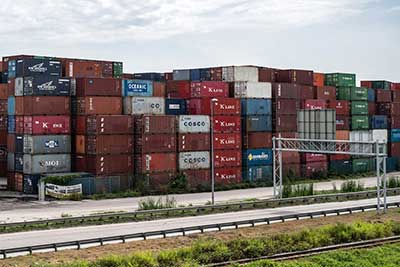Relevance: GS-3: Indian Economy and issues relating to planning, mobilization, of resources, growth, development and employment; Effects of liberalization on the economy, changes in industrial policy and their effects on industrial growth; Infrastructure: Energy, Ports, Roads, Airports, Railways etc.
Key Phrases: New warehousing policy, exclusive warehousing zones, public-private partnership (PPP), National Highways Authority of India (NHAI), logistics cost, multi-modal logistics parks, inter-modal connectivity, e-commerce sector, logistics and warehousing, LEADS 2021
Why in News?
- The government has proposed a new warehousing policy that will set the roadmap for development of exclusive warehousing zones in public-private partnership (PPP) mode to ease transportation and reduce logistics cost in India.
Keypoints:
- The new policy to be framed and implemented by National Highways Authority of India (NHAI) is aimed at improving logistics throughout the country.
- The modern warehouses will house cold-storage chains and will be able to store all kinds of cargo — wet and dry.
- The idea is to minimise pollution and traffic congestion in major
cities.
- These facilities are expected to come up outside city centres so that large trucks carrying the cargo do not need to enter the city to unload their goods.
- As these large vehicles can transport more goods compared to the smaller trucks, it will also help boost bulk carrying capacity and save fuel.
- There are land banks along the highways and expressways of the country
with the NHAI.
- Tenders will be floated for such land parcels, inviting private players to develop warehousing zones in PPP mode on a revenue-sharing basis or for a fixed fee. The terms of the agreements will be finalized later.
- The proposed warehousing zones are part of the initiatives taken by the
government to reform the transport sector, which accounts for a majority of
goods movement across India.
- Warehousing zones will help cut India’s logistics cost, which is 14%-16% of gross domestic product (GDP), compared to 8%-10% of GDP in China and 12%-13% in the US.
- The warehousing zones and multi-modal logistics parks (MMLPs) are being set up by the NHAI.
- The warehousing zones will help FMCG firms, steel and cement makers stock inventory near major hubs.
Globally, coastal transportation is the most favoured way followed by railways and then roads. But the trend is reverse in India where nearly 60% of the cargo is moved by road, 32% by rail and rest by the coastal shipping, airways and inland waterways.

- Integration of multi-modal transport includes development of 35
multi-modal logistics parks (MMLPs).
- The aim is to remove deficiencies related to logistics, draw the associated costs down, and strategically integrate highway projects and other connectivity initiatives such as inland water-ways and railways in tandem with the freight distribution ecosystem.
- The MMLPs are aimed at fostering inter-modal connectivity through dedicated railway lines and access from highways to provide connectivity to an airport or a seaport or an inland waterway terminal.
Warehousing Sector in India:
The warehousing sector in India has been on a high growth trajectory in recent years.
- Its first major stimulus came through the introduction of the GST regime in 2017, which saw the sector growing from 35 million sq. ft. (MSF) during 2015-17 to 77 MSF over 2018-20.
- And since last year Covid-19 has been accelerating its rise as one of India’s sunrise sectors
- Due to improved domestic capabilities in recent years, India has increasingly become an active player in the global manufacturing supply chain, supported by government initiatives such as Make in India, Aatmanirbhar Bharat and the PLI scheme. As a result, demand in the industrial and warehousing (I&W) sector has surged
- The e-commerce sector has been driving the demand for logistics and
warehousing across global markets and has emerged as the most prominent
driver of Indian warehousing market volumes along with the third party
logistics sector.
- This sector’s share in transactions has grown from 18% in FY17 to 31% in FY21. Amazon Inc. and Walmart Inc. backed Flipkart have driven the market.
- The Indian e-commerce market is on the cusp of its next phase of growth with Reliance Industries Ltd and the Tata group entering the fray.
Challenges:
- India’s supply chain faces barriers like unbalanced logistics modal mix, high indirect costs, fragmented infrastructure and networks, and limited technology adoption
- The most difficult aspect of the storage company is acquiring land, which is a rarity in a densely populated country like India.
- Moreover as more people shop online, retailers' footprints are diminishing. To compensate for the move from brick-and-mortar to e-commerce, warehouses will have to face a greater storage burden. This equates to a higher personnel requirement, which is exacerbated by tight labour markets.
- Availability of skilled manpower being a challenge, especially as growing automation has led to an increase in demand for skilled workers.
Conclusion:
- Efficient logistics ecosystem is considered to act as a catalyst in enhancing the competitiveness of all the sectors of the economy. Thus, improving supply chain efficiencies and reducing logistics costs are fundamental to India capitalizing on this strategic shift and meeting the well-defined aspiration to become a US$ 5 trillion economy by 2025.
The Ministry of Commerce and Industry has also crafted the Logistics Ease Across Different States (LEADS) 2021 to analyse the business environment in all State/UTs pertaining to infrastructure, policy, and regulatory regime for improving logistics efficiency in India.
Source: Live Mint
Mains Question:
Q. “To bridge the current competitiveness gap, India needs to reduce its logistics cost.” In this light comment on the need for a New Warehousing Policy. (250 Words).









